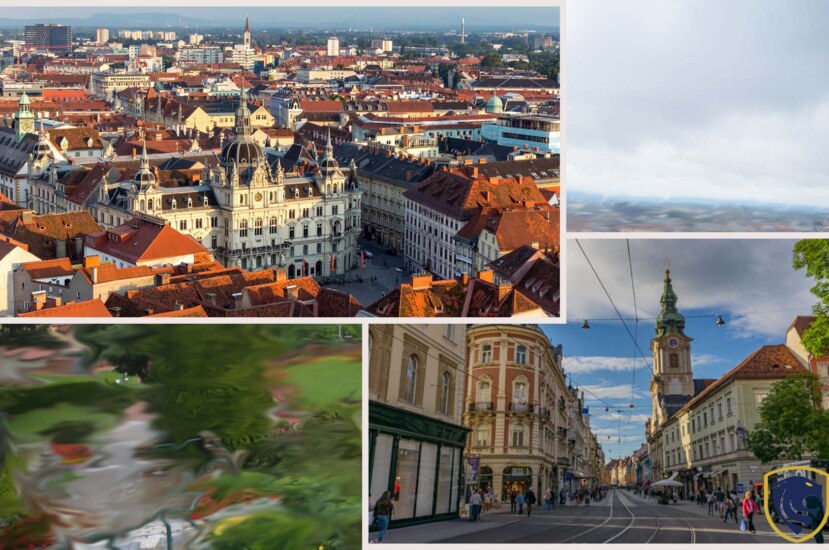Graz, Austria, reveals as a historical treasure trove, with a complex tapestry that intertwines with the city’s fundamental roots. Each cobblestone and aged stone gives evidence to centuries of cultural history, from the medieval splendor of the Old Town, a UNESCO World Heritage site, to the royal ruins atop Schlossberg (Castle Hill). Graz Cathedral and Emperor Ferdinand II’s Mausoleum are testaments to imperial authority and religious devotion, respectively, while Eggenberg Palace exemplifies the luxury of Baroque aesthetics. These historical sites construct a time-traveling story, encouraging visitors to immerse themselves in Graz’s ongoing historical charm.
Schlossberg (Castle Hill)
Schlossberg, or Castle Hill, is located in the center of Graz and serves as a prominent reminder of the city’s rich past. This hilltop retreat is home to ancient castle remains, an elegant clock tower, and stunning panoramic vistas. Also, Schlossberg is a key component of Graz’s UNESCO World Heritage Old Town. It promises a journey back in time, encouraging tourists to examine weathered stone ruins and experience legends from bygone times. The clock tower, known as Uhrturm, punctuates the skyline with its distinctive design, providing both historical importance and postcard-worthy photo possibilities. Moreover, as you climb the hill, you may hear whispers of old conflicts and royal intrigues. The top offers a panoramic view of the city’s lively blend of old and modern structures.

Schlossberg (Castle Hill)
The top offers a panoramic view of the city’s lively blend of old and modern structures. Schlossberg is more than just a hill. It’s a living history of Graz, a visible link between the present and the medieval past. In conclusion, Schlossberg encompasses Graz’s ageless attraction and calls history experts and casual travelers alike to go on a trip through Austria’s enthralling past, whether enjoying the vistas, meandering amid castle ruins, or soaking in the beauty of Uhrturm.
Graz Old Town (Altstadt)
Graz’s Old Town, or Altstadt, is a UNESCO World Heritage site that captures centuries of history in its small cobblestone alleys. The lively Main Square, Hauptplatz, is surrounded by architectural jewels from the medieval and Renaissance periods. The Rathaus, or Town Hall, stands proudly as a reminder of Graz’s municipal heritage. Another beauty is Landhaus, which has a Renaissance façade that captivates pedestrians. Wandering around Altstadt is like walking through a living museum, with each turn revealing the timeless beauty of well-preserved structures. Furthermore, the Old Town has a timeless beauty, with exquisite facades and historic landmarks reflecting the story of a city that has weathered the test of time.

Graz Old Town (Altstadt)
Aside from the architectural marvels, Altstadt is alive with small stores, warm cafés, and dynamic street scenes. Graz Old Town is more than simply a tourist attraction. It’s an immersive experience that invites tourists to journey into the past while enjoying the present. Also, Altstadt’s lit facades add a touch of magic when the day turns to night, creating a beautiful aura that further strengthens its standing as a must-see historical gem. Graz Old Town is more than simply a collection of structures. In conclusion Graz is a living, breathing tribute to the city’s long past, as well as an invitation to explore the heart of Austria’s second-largest city.
Graz Cathedral (Dom)
Graz Cathedral, often known as Dom, is a Gothic masterpiece in the city’s core. This religious structure, which dates back to the 15th century, is the seat of the Catholic Archdiocese of Graz-Seckau. Visitors are drawn on a spiritual journey through time by the cathedral’s awe-inspiring design and meticulous workmanship. Its piercing spires are a monument to both faith and skill. In addition, the interior has a reverent mood, with soaring vaulted ceilings and stained glass windows that bathe the interior in a celestial radiance. The altar, which is decorated with sacred art, is the main point of worship and contemplation.

Graz Cathedral (Dom)
Graz Cathedral is more than just a religious structure. It is a living witness to decades of dedication and architectural talent. The echoes of prayers and the weight of history provide a unique and humbling sensation when one stands within its hallowed walls. To sum up, Graz Cathedral stands as a light, encouraging visitors to observe the beautiful marriage of religion and craftsmanship in Austria’s second-largest city, whether for religious pilgrimage or historical inquiry.
The Mausoleum of Emperor Ferdinand II
The Mausoleum of Emperor Ferdinand II, located in the center of Graz, is a Baroque wonder that epitomizes imperial majesty. It was built in the 17th century. It serves as the ultimate resting place for Emperor Ferdinand II and his spouse. The facade of the tomb has elaborate decoration that reflects the luxury of the time. Also, in the inside, visitors are welcomed by a symphony of Baroque grandeur. In addition, there are beautiful paintings gracing the ceilings and exquisite sculptures line the walls. Moreover, the emperor’s and his wife’s graves grab attention with their imposing presence. Also, it provides a look into the bygone realm of royal luxury.

The Mausoleum of Emperor Ferdinand II
Visitors are taken back in time as they walk through its ancient halls, to a time when art and architecture were associated with imperial heritage. The Mausoleum of Emperor Ferdinand II is a testimony to the cultural riches of the Baroque era. It enables history and architectural enthusiasts to immerse themselves in the sumptuous heritage of Austrian royalty.
Eggenberg Palace (Schloss Eggenberg)
Schloss Eggenberg, also known as Eggenberg Palace, is a Baroque jewel in Graz, Austria. This 17th-century UNESCO World Heritage monument oozes luxury and cultural value. The facade of the palace, which is embellished with exquisite gardens, shows the grandeur of its aristocratic past. The Alte Galerie contains a large collection of European art spanning ages and genres. Also, visitors may see paintings while strolling through immaculately conserved rooms. The palace’s distinctive architecture and theme design offer an immersive experience that reflects the aesthetic preferences of its noble occupants. Moreover, the Eggenberg Palace is more than simply a museum. It is a living witness to the creative and architectural triumphs of the Baroque era.

Eggenberg Palace (Schloss Eggenberg)
The surrounding gardens, painstakingly designed in the Baroque style, provide a calm haven for tourists, encouraging them to explore pathways ornamented with statues and fountains. The palace and its grounds offer a complete trip through time, allowing visitors to experience both the material beauty and cultural heritage of Graz’s aristocratic history. The mix of art, architecture, and environment produces a memorable story as one visits Schloss Eggenberg, making it a must-visit site for anyone looking to dig into the lush tapestry of Austrian heritage.


